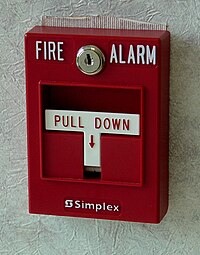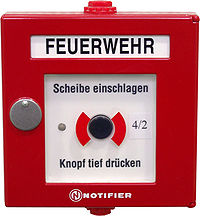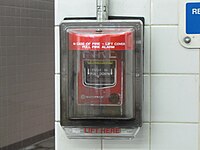I Pulled the Fire Alarm and Id It Again Too See

Simplex single activity "T-bar" pull station

A manual phone call point in the European union (EU) with standard EN 54-11

An activated manual phone call point in Japan. Telephone jacks are visible below the open comprehend.

High german manual call point with paint from NOTIFIER (Honeywell)
Manual burn alarm activation is typically accomplished through the use of a pull station (U.s. & Canada) or call point (Europe, Australia, and Asia), which then sounds the evacuation alarm for the relevant building or zone. Manual burn alarm activation requires human intervention, as distinct from automatic burn down alarm activation such as that provided through the use of heat detectors and fume detectors. It is, however, possible for call points/pull stations to be used in conjunction with automated detection as part of the overall burn detection and alarm system. Systems in completed buildings tend to be wired in and include a control panel. Systems for use during construction can too be wireless or mechanical, it is recommended by the Structural Timber Association in the United kingdom of great britain and northern ireland that for timber-framed constructions, interconnecting wireless systems exist used.[1]
Burn down alarm pull station [edit]
A burn down alarm pull station is an active burn down protection device, usually wall-mounted, that, when activated, initiates an alarm on a fire alarm system. In its simplest course, the user activates the alarm past pulling the handle down, which completes a circuit and locks the handle in the activated position, sending an alarm to the fire alarm control panel. After operation, most fire alarm pull stations must be restored to the fix position using a special tool or key for the panel to be reset. Archaic transmission stations, requiring simply a single action or hand motion to activate, can be subject to unwanted activation by jarring or accidental contact. Early strategies to cope with this problem included requiring the operator to break a pane of glass to release an internal spring-operated mechanism. Manual pull stations that require two manus motions, such every bit elevator upwardly and pull downwardly, or push in and pull down, have since replaced the break-drinking glass and single-activeness models in many mod installations.
Coded pull stations [edit]
In the past, pull stations controlled the entire system. These coded pull stations were much bigger than modern pulls and had a lawmaking wheel in them. They had a gear mechanism that was wound up when the station was pulled, and (unlike modern pull stations) the handle did not stay downwards. The gears would turn a pocket-sized bicycle with a specific number of teeth, which determined the coding. The teeth would push up on a contact, which would open up and shut a excursion, pulsing the code to the bells or horns. This code was used past building security to make up one's mind where the alert was originating from. For example, consider a pull station in the quaternary-floor elevator antechamber of an office building with a code of five-three-1. When the station was pulled, the security officers in the edifice would expect upwards 5-three-i in a master list of codes. Afterward finding the location of the pull, they would check to meet if there is a real burn down. If there was, they would evacuate the building and telephone call the burn department.

System tests could exist conducted in one of ii means: In a coded pull station, there is either a examination hole on the front (usually activated with an Allen wrench) or a test switch on the inside. Turning the switch one mode causes the notification appliances to sound continuous (or in the case of unmarried-stroke bells, ding in one case). Turning it the other way and then activating the pull allows a silent test to be washed in which the station'southward mechanical parts are checked to ensure proper function. Once pulled, the station would do at least iv rounds of lawmaking before resetting itself. Coded pulls were typically used in new burn down alarm systems until roughly the 1950s, and and then occasionally into the 1970s. Until the early on 1990s, some panels were fabricated with an extra zone to accommodate any existing coded pull stations. Nowadays, coded pull stations are rarely seen in working fire alarm systems.
Modern pull stations [edit]
Many modern burn down alarm pull stations are single action and merely require the user to pull downwards the handle to audio the alert. Other burn alarm pull stations are dual-action, and every bit such crave the user to perform a second task earlier pulling down, such every bit lifting or pushing in a panel on the station or shattering a glass console with an fastened hammer. Perhaps the most recognizable pull station is the "T-bar"-way pull station, and so named because the handle is shaped like the letter "T". This style is manufactured by many companies, most notably SimplexGrinnell.

Activated Notifier NBG-12 pull station underneath a Stopper cover
Resetting a fire alarm pull station afterwards it has been operated normally requires building personnel or emergency responders to open up the station using a central, which often is either a hex key or a more traditional central. Opening the station causes the handle to go dorsum to its original position, allowing the alarm to exist reset from the burn alarm control panel after the station has been closed.
In some places, particularly at college dormitories and schools, students set off fire alarms as a prank or only because they want to (out of acrimony, marvel, revenge, or to postpone a test). These false alarms can convey risk to alarm fatigue if they occur repeatedly, causing occupants to dismiss the importance of alarms or ignore them completely. In areas where false alarms are a recurring problem, pull stations may be covered with a articulate plastic encompass (sold under the "Stopper" trade proper noun) that will cause people to discover the person by sounding an alert when tinkered with or opened, creating a focus on the fire alarm. Because of these and other issues, setting off a fire alarm when there is no fire or other emergency is illegal in near jurisdictions.
Manual call points [edit]
In Europe, Australia, New Zealand, parts of Canada and Asia pull stations are generally not used; instead of a transmission telephone call betoken is used, which is commonly referred to as an MCP, call betoken, or Fire Point inside the fire protection industry and as a "transmitter" in Japan. They are used to allow building occupants to signal that a burn or other emergency exists inside the building. When activated they will enhance a plastic flag out of the top to tell which alarm was activated. They are usually connected to a fundamental fire alarm console which is in plough continued to an alarm system in the building, and often to a local fire brigade dispatcher besides. The first modern MCP arrived in Europe in 1972 and was developed past KAC.[ii]
Transmission call points are used to initiate an alert signal and operate using a simple push button press or when glass is cleaved revealing a button. They can form part of a manual alarm system or an automated alert organisation. There will be an indicator on the monitoring unit of measurement for visual indication to locate the call point easily, and there should exist a visual identifier of the unit of measurement which triggered the alarm, typically a mechanical flag that operates on a latch and must be manually reset, due east.yard. past a key.

Previously, the onetime British standard did not allow hinged covers and plastic resettable elements. Plastic elements must accept the same printing every bit the EN 54 drinking glass.

An older Legrand Transmission call point. This call point uses a lever-shaped key to reset.
Temporary MCPs [edit]
It is condign increasingly common in the Britain and Europe for wireless MCPs to be used in temporary environments such every bit construction sites.[3] These typically provide the same level of protection every bit a standard wired burn down alarm installation, merely can be moved around as needed in the changing environment of a edifice under construction without the need for specialist electrician installation. They often combine call bespeak functionality with sounder and strobe functions for ease of installation.
Such systems typically operate a similar structure to a standard wired fire alarm network, in that Manual Phone call Points may be mixed with automatic fire detection in the form of heat detection and smoke detection (often specially designed to be grit resistant, due to the increased likelihood of dust on a construction site) and can be connected to a monitoring base station unit of measurement. This unit provides visual identification of the triggering unit in any warning, and should besides be able to monitor radio indicate forcefulness (which may change as the build progresses) and battery life.
Due to their use for life inherent purposes, radio receivers used in such systems should exist of Category ane[iv] standard.
European Standard [edit]
Fire detection and alarm products placed on the market within the European Matrimony must, following Regulation (European union) No 305/2011, adjust to the European harmonized technical standard EN 54 Fire Detection and Fire Alarm Systems.
EN 54 part 11 is the section of the mandatory standard relating to transmission call points.
European Committee for Standardization (CEN, French: Comité Européen de Normalisation) is responsible for the development and maintenance of the standard, as part of its remit for developing harmonized European standards for free movement of goods in the European Wedlock countries.
The EN 54 certification of each device has to be issued annually, and for products of this nature must be issued past a notified torso post-obit the stringent testing procedures outlined inside the standard.
If an EN 54 document is over one year old, it has expired and it is not a valid certificate. Manufacturers can not sell or install the device with expired certification in any country of the Eu.[5] [6]
See besides [edit]
- Fire condom
References [edit]
- ^ "Structural Timber Association - sixteen Steps to Fire Safety". Structural Timber Association. Archived from the original on 2014-07-16. Retrieved 2015-04-17 .
- ^ "KAC Home Page". Kac.co.united kingdom of great britain and northern ireland. Retrieved 2009-07-16 .
- ^ "Construction News". Construction News. EMAP Publishing Ltd. 2015-12-18. Retrieved 2015-04-17 .
- ^ Short Range Devices
- ^ "Archived copy". Archived from the original on 2013-05-twenty. Retrieved 2012-12-28 .
{{cite web}}: CS1 maint: archived copy equally title (link) - ^ Burn Alarm Supplier Miami
External links [edit]
- Video demonstrating a coded pull station made by Simplex.
Source: https://en.wikipedia.org/wiki/Manual_fire_alarm_activation
0 Response to "I Pulled the Fire Alarm and Id It Again Too See"
Postar um comentário